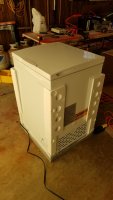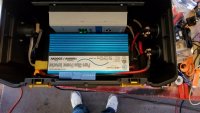GWguy
*
Set it all up today, didn't expect much with the lack of sun. Even in this overcast, it's still producing 38VDC open circuit. Connected, I'm getting 14-20VDC and about .5-.8A. It's not enough to cover the usage of the fridge while running but since the fridge only runs 7-8% of the time, the other 92-93% of the time it's trickle charging and makes up for what was used over the long run.
Found a small wheeled toolbox at BJs for cheap. Going to mount the battery, inverter, solar charger and wiring in it for a nice clean portable system. Ordered some surface-mount cutoff switches for the battery and inverter. Tractor Supply has a nice full sine wave inverter for a lot less than others I've seen. Might do that.
Have to admit, this has been a fun project, regardless of whether it worked or not.
Found a small wheeled toolbox at BJs for cheap. Going to mount the battery, inverter, solar charger and wiring in it for a nice clean portable system. Ordered some surface-mount cutoff switches for the battery and inverter. Tractor Supply has a nice full sine wave inverter for a lot less than others I've seen. Might do that.
Have to admit, this has been a fun project, regardless of whether it worked or not.









